Leadership and People Management Report: Aviation Shortage Analysis
VerifiedAdded on 2022/08/12
|15
|4206
|17
Report
AI Summary
This report delves into the challenges of leadership and people management within the international aviation industry, specifically addressing the critical shortage of Air Traffic Controllers (ATCs). It begins with an introduction highlighting the importance of effective human resource management and organizational behavior in meeting the demands of a growing aviation sector. The report then explores the significance of training and diversity management, reviewing various models such as the system, transition, instructional system development, and supportive models. The analysis section identifies key training needs and organizational behavior aspects crucial for enhancing the recruitment and retention of ATCs. The discussion part emphasizes the importance of skills development and the implementation of diversity management practices to create a balanced and motivated workforce. The report concludes with recommendations for improving the supply of competent ATCs, emphasizing the need for tailored training programs and inclusive workplace environments to meet the industry's growing demands. The report is based on the provided case study and module materials, offering a comprehensive overview of the challenges and potential solutions in the aviation industry.
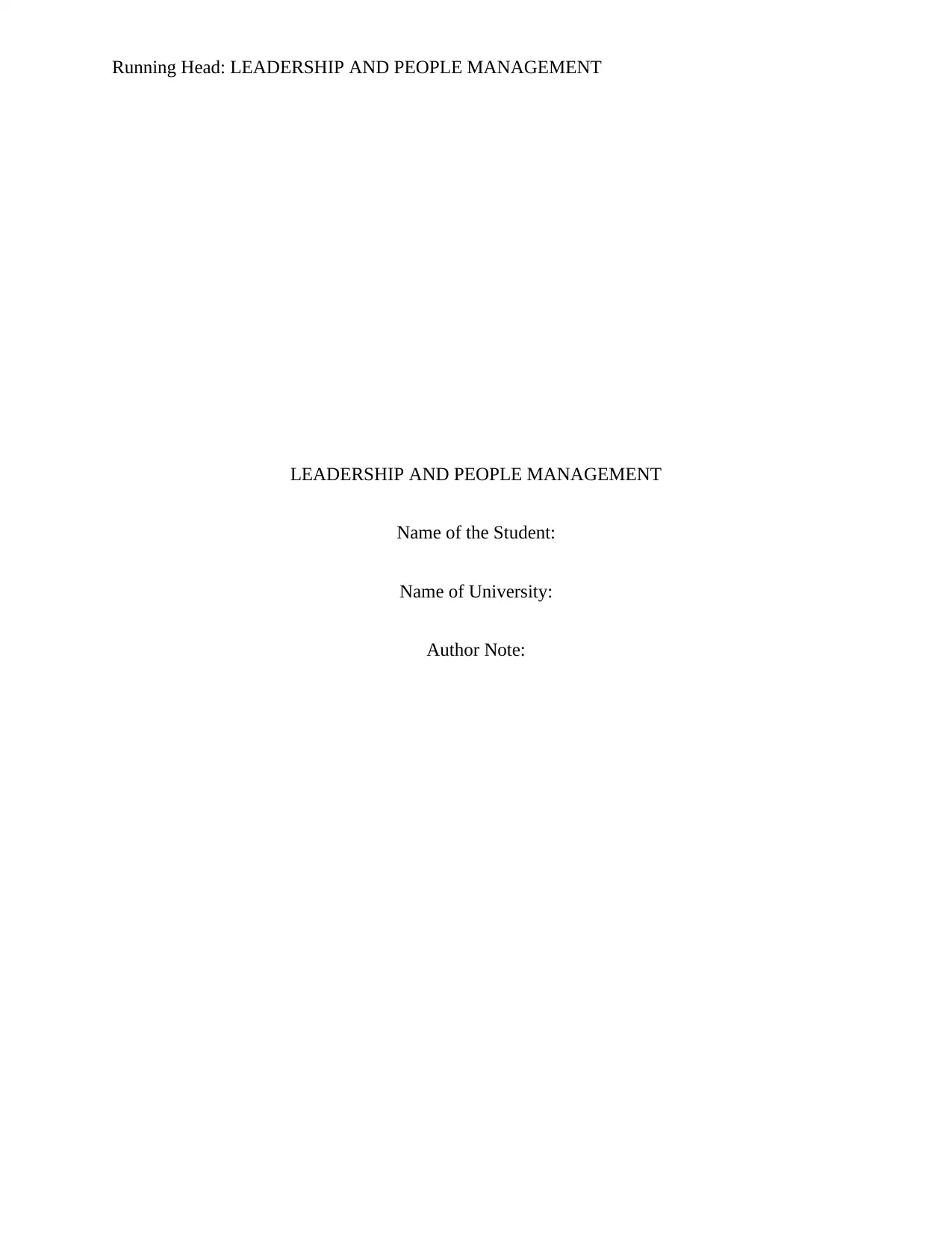
Running Head: LEADERSHIP AND PEOPLE MANAGEMENT
LEADERSHIP AND PEOPLE MANAGEMENT
Name of the Student:
Name of University:
Author Note:
LEADERSHIP AND PEOPLE MANAGEMENT
Name of the Student:
Name of University:
Author Note:
Paraphrase This Document
Need a fresh take? Get an instant paraphrase of this document with our AI Paraphraser
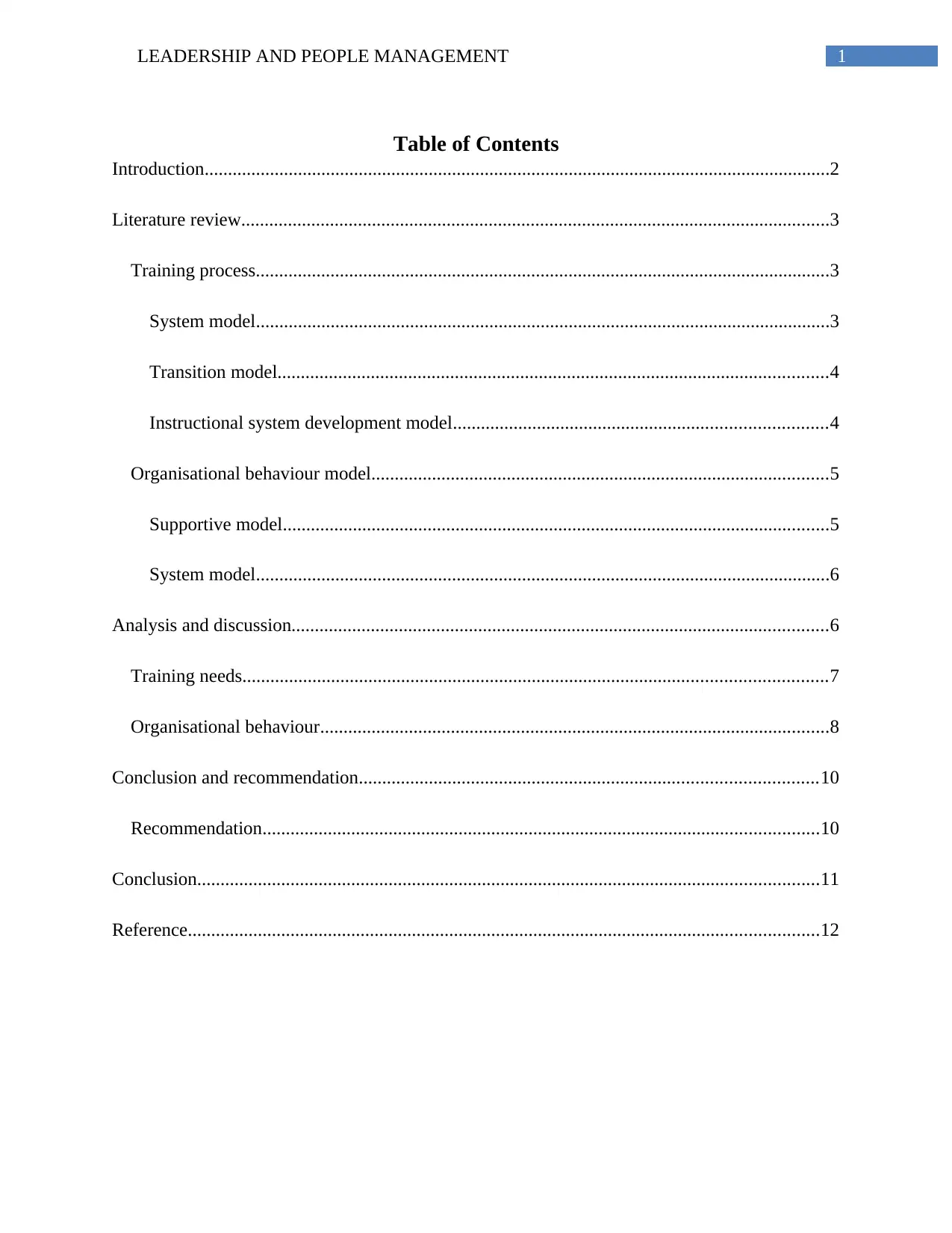
1LEADERSHIP AND PEOPLE MANAGEMENT
Table of Contents
Introduction......................................................................................................................................2
Literature review..............................................................................................................................3
Training process...........................................................................................................................3
System model...........................................................................................................................3
Transition model......................................................................................................................4
Instructional system development model................................................................................4
Organisational behaviour model..................................................................................................5
Supportive model.....................................................................................................................5
System model...........................................................................................................................6
Analysis and discussion...................................................................................................................6
Training needs.............................................................................................................................7
Organisational behaviour.............................................................................................................8
Conclusion and recommendation..................................................................................................10
Recommendation.......................................................................................................................10
Conclusion.....................................................................................................................................11
Reference.......................................................................................................................................12
Table of Contents
Introduction......................................................................................................................................2
Literature review..............................................................................................................................3
Training process...........................................................................................................................3
System model...........................................................................................................................3
Transition model......................................................................................................................4
Instructional system development model................................................................................4
Organisational behaviour model..................................................................................................5
Supportive model.....................................................................................................................5
System model...........................................................................................................................6
Analysis and discussion...................................................................................................................6
Training needs.............................................................................................................................7
Organisational behaviour.............................................................................................................8
Conclusion and recommendation..................................................................................................10
Recommendation.......................................................................................................................10
Conclusion.....................................................................................................................................11
Reference.......................................................................................................................................12
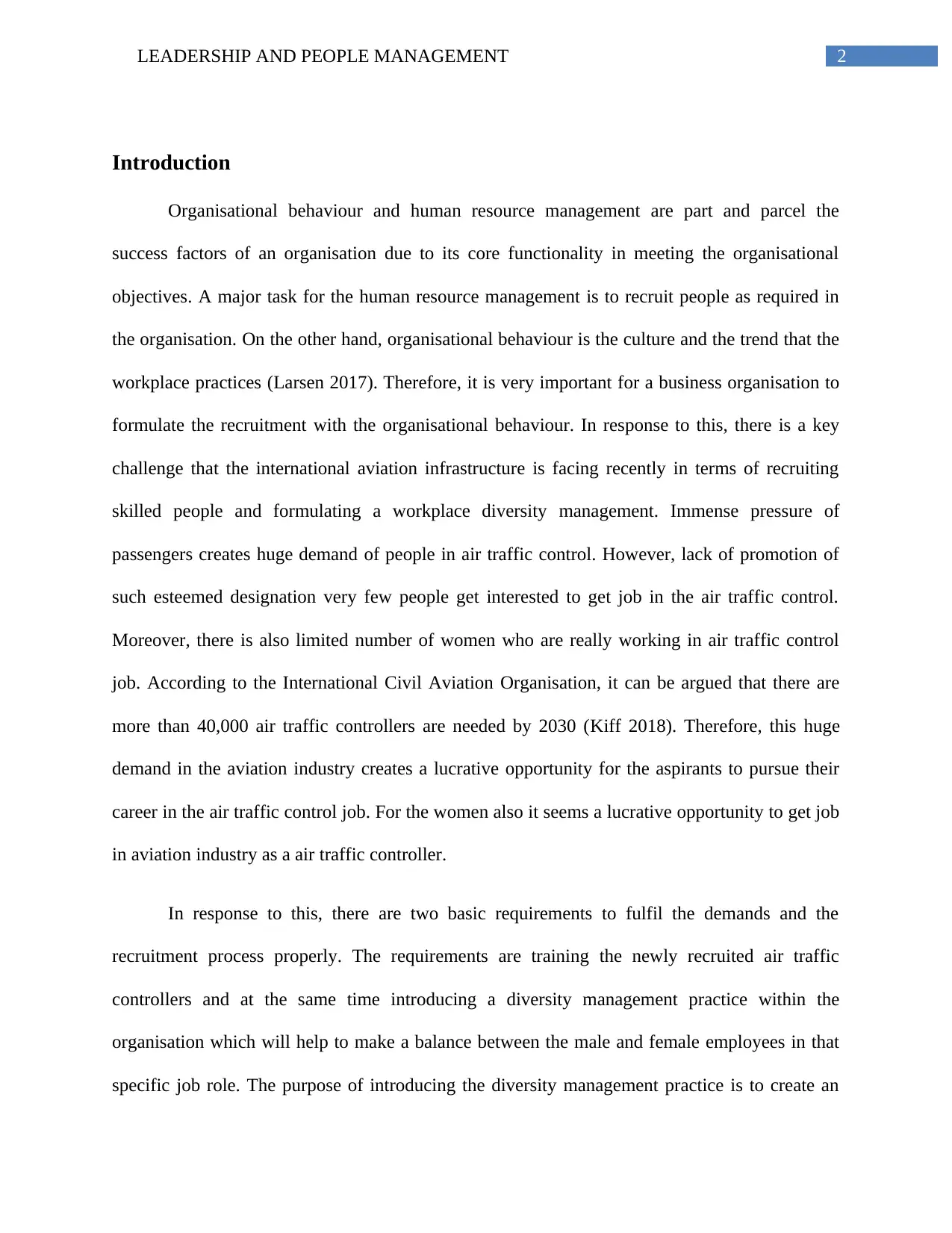
2LEADERSHIP AND PEOPLE MANAGEMENT
Introduction
Organisational behaviour and human resource management are part and parcel the
success factors of an organisation due to its core functionality in meeting the organisational
objectives. A major task for the human resource management is to recruit people as required in
the organisation. On the other hand, organisational behaviour is the culture and the trend that the
workplace practices (Larsen 2017). Therefore, it is very important for a business organisation to
formulate the recruitment with the organisational behaviour. In response to this, there is a key
challenge that the international aviation infrastructure is facing recently in terms of recruiting
skilled people and formulating a workplace diversity management. Immense pressure of
passengers creates huge demand of people in air traffic control. However, lack of promotion of
such esteemed designation very few people get interested to get job in the air traffic control.
Moreover, there is also limited number of women who are really working in air traffic control
job. According to the International Civil Aviation Organisation, it can be argued that there are
more than 40,000 air traffic controllers are needed by 2030 (Kiff 2018). Therefore, this huge
demand in the aviation industry creates a lucrative opportunity for the aspirants to pursue their
career in the air traffic control job. For the women also it seems a lucrative opportunity to get job
in aviation industry as a air traffic controller.
In response to this, there are two basic requirements to fulfil the demands and the
recruitment process properly. The requirements are training the newly recruited air traffic
controllers and at the same time introducing a diversity management practice within the
organisation which will help to make a balance between the male and female employees in that
specific job role. The purpose of introducing the diversity management practice is to create an
Introduction
Organisational behaviour and human resource management are part and parcel the
success factors of an organisation due to its core functionality in meeting the organisational
objectives. A major task for the human resource management is to recruit people as required in
the organisation. On the other hand, organisational behaviour is the culture and the trend that the
workplace practices (Larsen 2017). Therefore, it is very important for a business organisation to
formulate the recruitment with the organisational behaviour. In response to this, there is a key
challenge that the international aviation infrastructure is facing recently in terms of recruiting
skilled people and formulating a workplace diversity management. Immense pressure of
passengers creates huge demand of people in air traffic control. However, lack of promotion of
such esteemed designation very few people get interested to get job in the air traffic control.
Moreover, there is also limited number of women who are really working in air traffic control
job. According to the International Civil Aviation Organisation, it can be argued that there are
more than 40,000 air traffic controllers are needed by 2030 (Kiff 2018). Therefore, this huge
demand in the aviation industry creates a lucrative opportunity for the aspirants to pursue their
career in the air traffic control job. For the women also it seems a lucrative opportunity to get job
in aviation industry as a air traffic controller.
In response to this, there are two basic requirements to fulfil the demands and the
recruitment process properly. The requirements are training the newly recruited air traffic
controllers and at the same time introducing a diversity management practice within the
organisation which will help to make a balance between the male and female employees in that
specific job role. The purpose of introducing the diversity management practice is to create an
⊘ This is a preview!⊘
Do you want full access?
Subscribe today to unlock all pages.

Trusted by 1+ million students worldwide
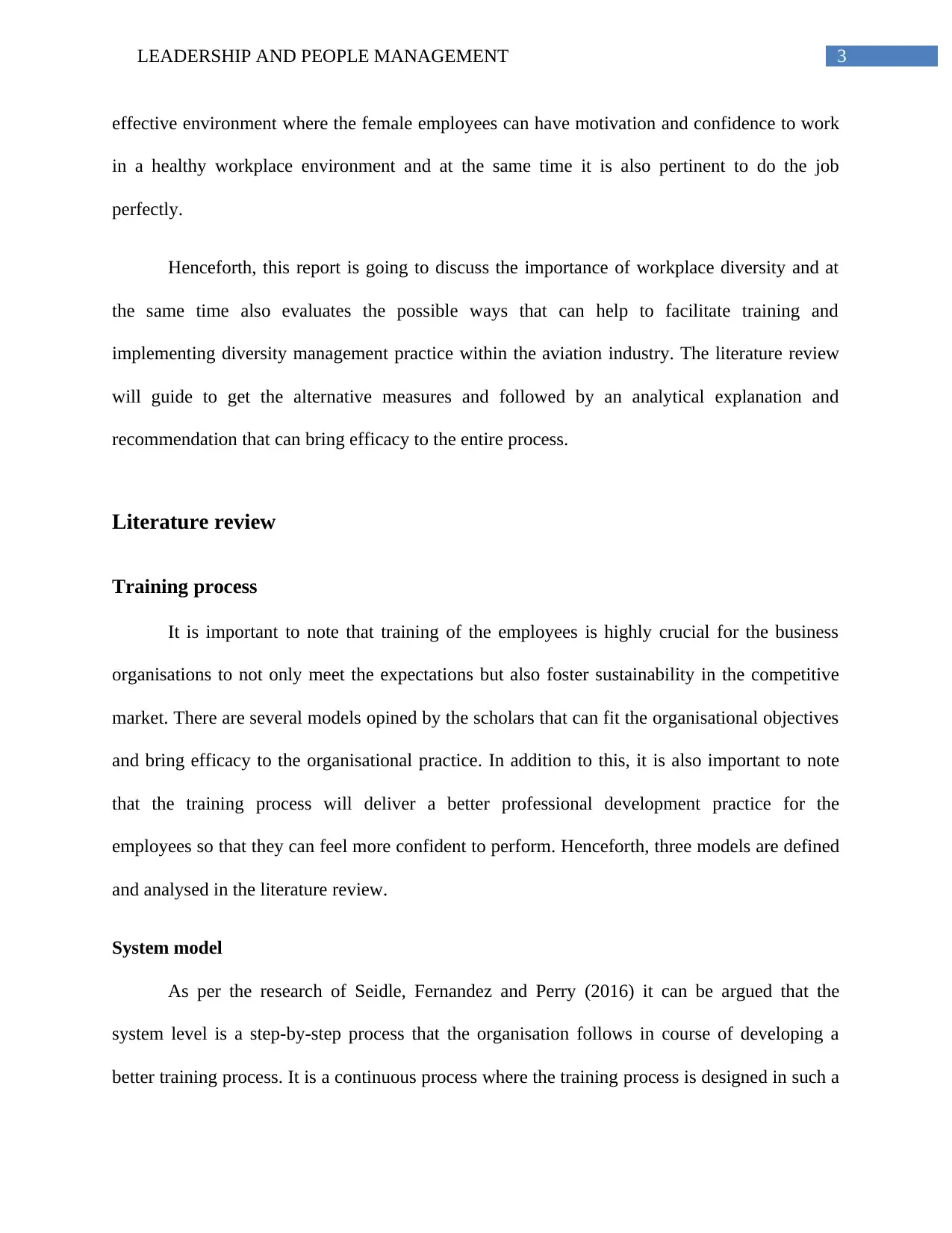
3LEADERSHIP AND PEOPLE MANAGEMENT
effective environment where the female employees can have motivation and confidence to work
in a healthy workplace environment and at the same time it is also pertinent to do the job
perfectly.
Henceforth, this report is going to discuss the importance of workplace diversity and at
the same time also evaluates the possible ways that can help to facilitate training and
implementing diversity management practice within the aviation industry. The literature review
will guide to get the alternative measures and followed by an analytical explanation and
recommendation that can bring efficacy to the entire process.
Literature review
Training process
It is important to note that training of the employees is highly crucial for the business
organisations to not only meet the expectations but also foster sustainability in the competitive
market. There are several models opined by the scholars that can fit the organisational objectives
and bring efficacy to the organisational practice. In addition to this, it is also important to note
that the training process will deliver a better professional development practice for the
employees so that they can feel more confident to perform. Henceforth, three models are defined
and analysed in the literature review.
System model
As per the research of Seidle, Fernandez and Perry (2016) it can be argued that the
system level is a step-by-step process that the organisation follows in course of developing a
better training process. It is a continuous process where the training process is designed in such a
effective environment where the female employees can have motivation and confidence to work
in a healthy workplace environment and at the same time it is also pertinent to do the job
perfectly.
Henceforth, this report is going to discuss the importance of workplace diversity and at
the same time also evaluates the possible ways that can help to facilitate training and
implementing diversity management practice within the aviation industry. The literature review
will guide to get the alternative measures and followed by an analytical explanation and
recommendation that can bring efficacy to the entire process.
Literature review
Training process
It is important to note that training of the employees is highly crucial for the business
organisations to not only meet the expectations but also foster sustainability in the competitive
market. There are several models opined by the scholars that can fit the organisational objectives
and bring efficacy to the organisational practice. In addition to this, it is also important to note
that the training process will deliver a better professional development practice for the
employees so that they can feel more confident to perform. Henceforth, three models are defined
and analysed in the literature review.
System model
As per the research of Seidle, Fernandez and Perry (2016) it can be argued that the
system level is a step-by-step process that the organisation follows in course of developing a
better training process. It is a continuous process where the training process is designed in such a
Paraphrase This Document
Need a fresh take? Get an instant paraphrase of this document with our AI Paraphraser
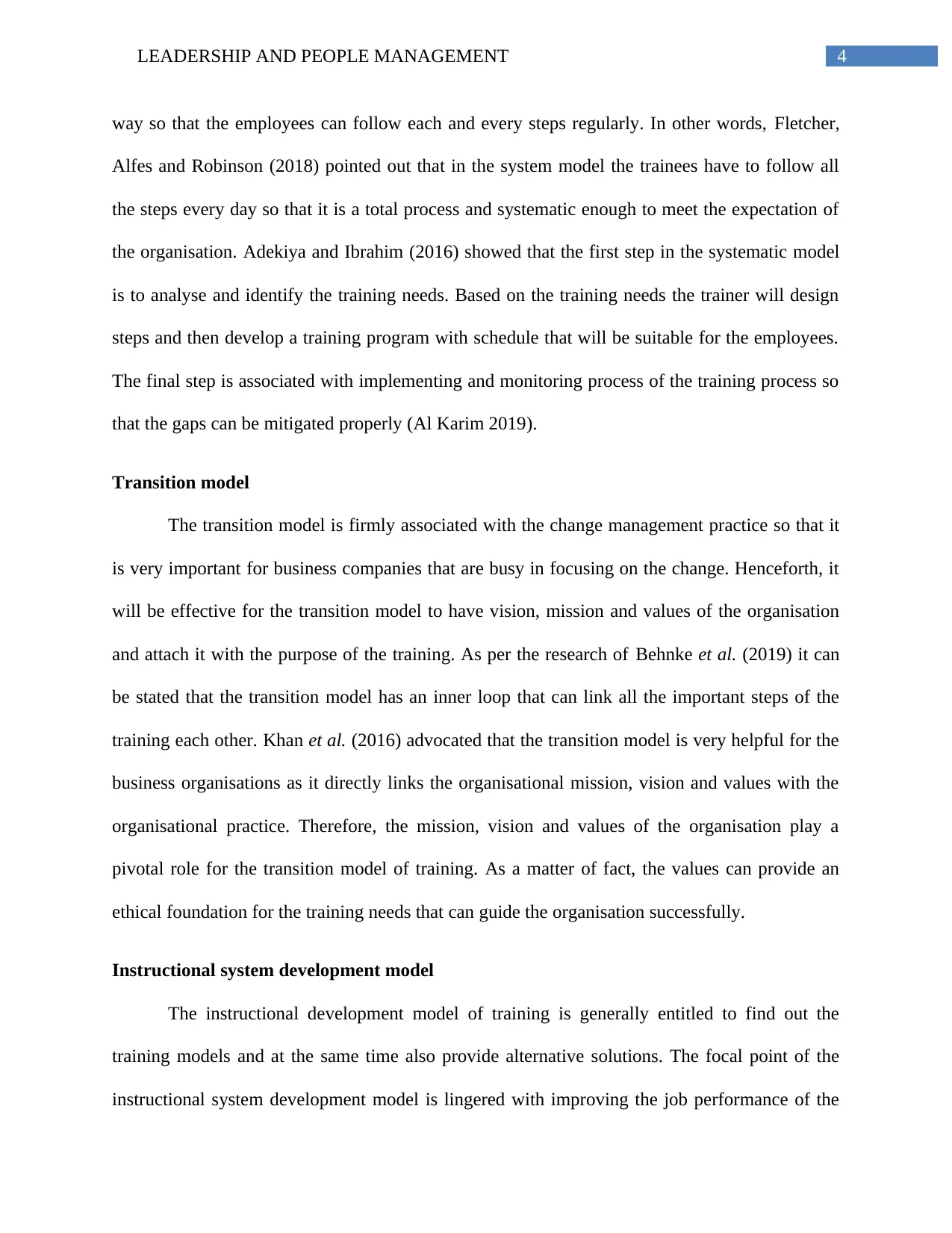
4LEADERSHIP AND PEOPLE MANAGEMENT
way so that the employees can follow each and every steps regularly. In other words, Fletcher,
Alfes and Robinson (2018) pointed out that in the system model the trainees have to follow all
the steps every day so that it is a total process and systematic enough to meet the expectation of
the organisation. Adekiya and Ibrahim (2016) showed that the first step in the systematic model
is to analyse and identify the training needs. Based on the training needs the trainer will design
steps and then develop a training program with schedule that will be suitable for the employees.
The final step is associated with implementing and monitoring process of the training process so
that the gaps can be mitigated properly (Al Karim 2019).
Transition model
The transition model is firmly associated with the change management practice so that it
is very important for business companies that are busy in focusing on the change. Henceforth, it
will be effective for the transition model to have vision, mission and values of the organisation
and attach it with the purpose of the training. As per the research of Behnke et al. (2019) it can
be stated that the transition model has an inner loop that can link all the important steps of the
training each other. Khan et al. (2016) advocated that the transition model is very helpful for the
business organisations as it directly links the organisational mission, vision and values with the
organisational practice. Therefore, the mission, vision and values of the organisation play a
pivotal role for the transition model of training. As a matter of fact, the values can provide an
ethical foundation for the training needs that can guide the organisation successfully.
Instructional system development model
The instructional development model of training is generally entitled to find out the
training models and at the same time also provide alternative solutions. The focal point of the
instructional system development model is lingered with improving the job performance of the
way so that the employees can follow each and every steps regularly. In other words, Fletcher,
Alfes and Robinson (2018) pointed out that in the system model the trainees have to follow all
the steps every day so that it is a total process and systematic enough to meet the expectation of
the organisation. Adekiya and Ibrahim (2016) showed that the first step in the systematic model
is to analyse and identify the training needs. Based on the training needs the trainer will design
steps and then develop a training program with schedule that will be suitable for the employees.
The final step is associated with implementing and monitoring process of the training process so
that the gaps can be mitigated properly (Al Karim 2019).
Transition model
The transition model is firmly associated with the change management practice so that it
is very important for business companies that are busy in focusing on the change. Henceforth, it
will be effective for the transition model to have vision, mission and values of the organisation
and attach it with the purpose of the training. As per the research of Behnke et al. (2019) it can
be stated that the transition model has an inner loop that can link all the important steps of the
training each other. Khan et al. (2016) advocated that the transition model is very helpful for the
business organisations as it directly links the organisational mission, vision and values with the
organisational practice. Therefore, the mission, vision and values of the organisation play a
pivotal role for the transition model of training. As a matter of fact, the values can provide an
ethical foundation for the training needs that can guide the organisation successfully.
Instructional system development model
The instructional development model of training is generally entitled to find out the
training models and at the same time also provide alternative solutions. The focal point of the
instructional system development model is lingered with improving the job performance of the
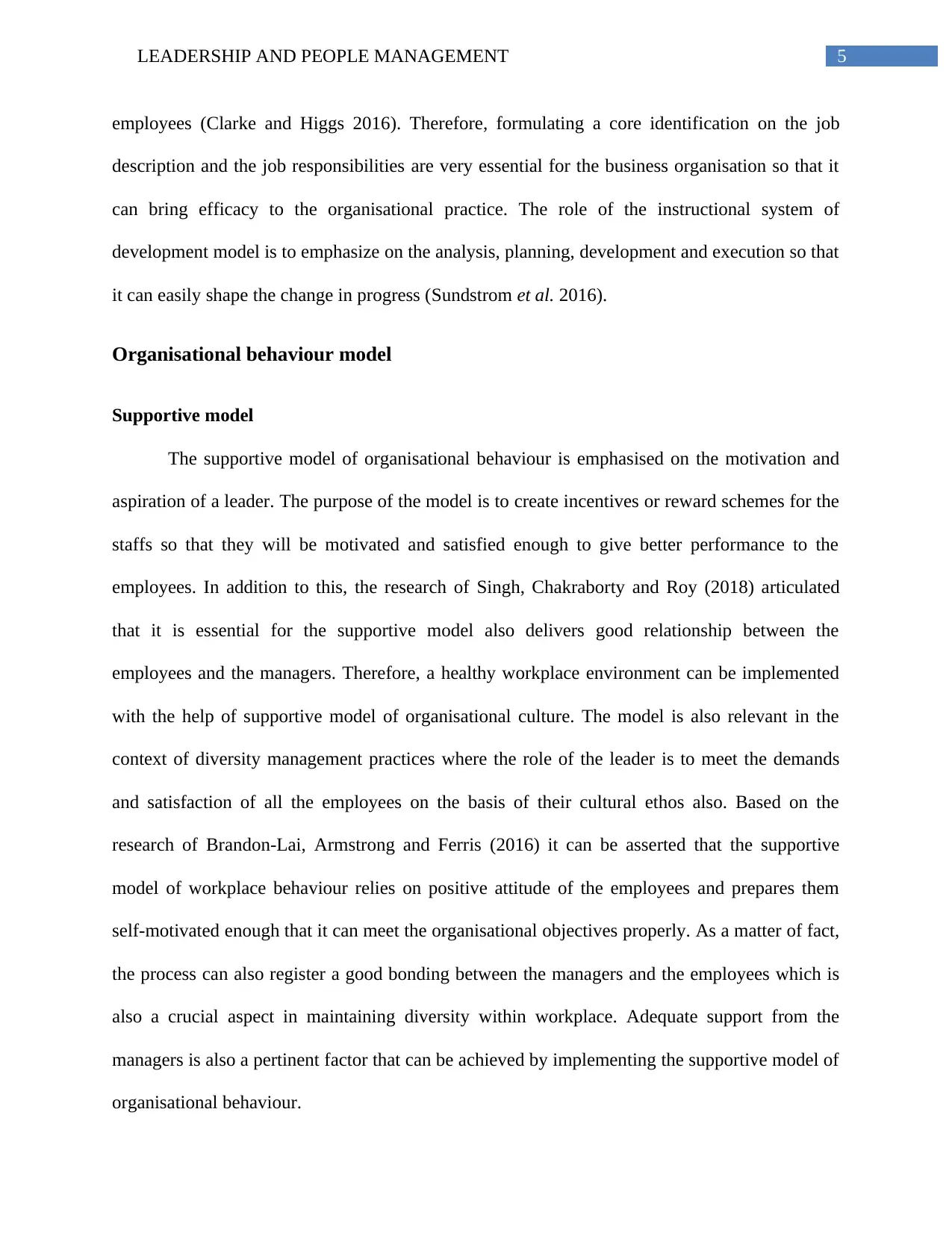
5LEADERSHIP AND PEOPLE MANAGEMENT
employees (Clarke and Higgs 2016). Therefore, formulating a core identification on the job
description and the job responsibilities are very essential for the business organisation so that it
can bring efficacy to the organisational practice. The role of the instructional system of
development model is to emphasize on the analysis, planning, development and execution so that
it can easily shape the change in progress (Sundstrom et al. 2016).
Organisational behaviour model
Supportive model
The supportive model of organisational behaviour is emphasised on the motivation and
aspiration of a leader. The purpose of the model is to create incentives or reward schemes for the
staffs so that they will be motivated and satisfied enough to give better performance to the
employees. In addition to this, the research of Singh, Chakraborty and Roy (2018) articulated
that it is essential for the supportive model also delivers good relationship between the
employees and the managers. Therefore, a healthy workplace environment can be implemented
with the help of supportive model of organisational culture. The model is also relevant in the
context of diversity management practices where the role of the leader is to meet the demands
and satisfaction of all the employees on the basis of their cultural ethos also. Based on the
research of Brandon-Lai, Armstrong and Ferris (2016) it can be asserted that the supportive
model of workplace behaviour relies on positive attitude of the employees and prepares them
self-motivated enough that it can meet the organisational objectives properly. As a matter of fact,
the process can also register a good bonding between the managers and the employees which is
also a crucial aspect in maintaining diversity within workplace. Adequate support from the
managers is also a pertinent factor that can be achieved by implementing the supportive model of
organisational behaviour.
employees (Clarke and Higgs 2016). Therefore, formulating a core identification on the job
description and the job responsibilities are very essential for the business organisation so that it
can bring efficacy to the organisational practice. The role of the instructional system of
development model is to emphasize on the analysis, planning, development and execution so that
it can easily shape the change in progress (Sundstrom et al. 2016).
Organisational behaviour model
Supportive model
The supportive model of organisational behaviour is emphasised on the motivation and
aspiration of a leader. The purpose of the model is to create incentives or reward schemes for the
staffs so that they will be motivated and satisfied enough to give better performance to the
employees. In addition to this, the research of Singh, Chakraborty and Roy (2018) articulated
that it is essential for the supportive model also delivers good relationship between the
employees and the managers. Therefore, a healthy workplace environment can be implemented
with the help of supportive model of organisational culture. The model is also relevant in the
context of diversity management practices where the role of the leader is to meet the demands
and satisfaction of all the employees on the basis of their cultural ethos also. Based on the
research of Brandon-Lai, Armstrong and Ferris (2016) it can be asserted that the supportive
model of workplace behaviour relies on positive attitude of the employees and prepares them
self-motivated enough that it can meet the organisational objectives properly. As a matter of fact,
the process can also register a good bonding between the managers and the employees which is
also a crucial aspect in maintaining diversity within workplace. Adequate support from the
managers is also a pertinent factor that can be achieved by implementing the supportive model of
organisational behaviour.
⊘ This is a preview!⊘
Do you want full access?
Subscribe today to unlock all pages.

Trusted by 1+ million students worldwide
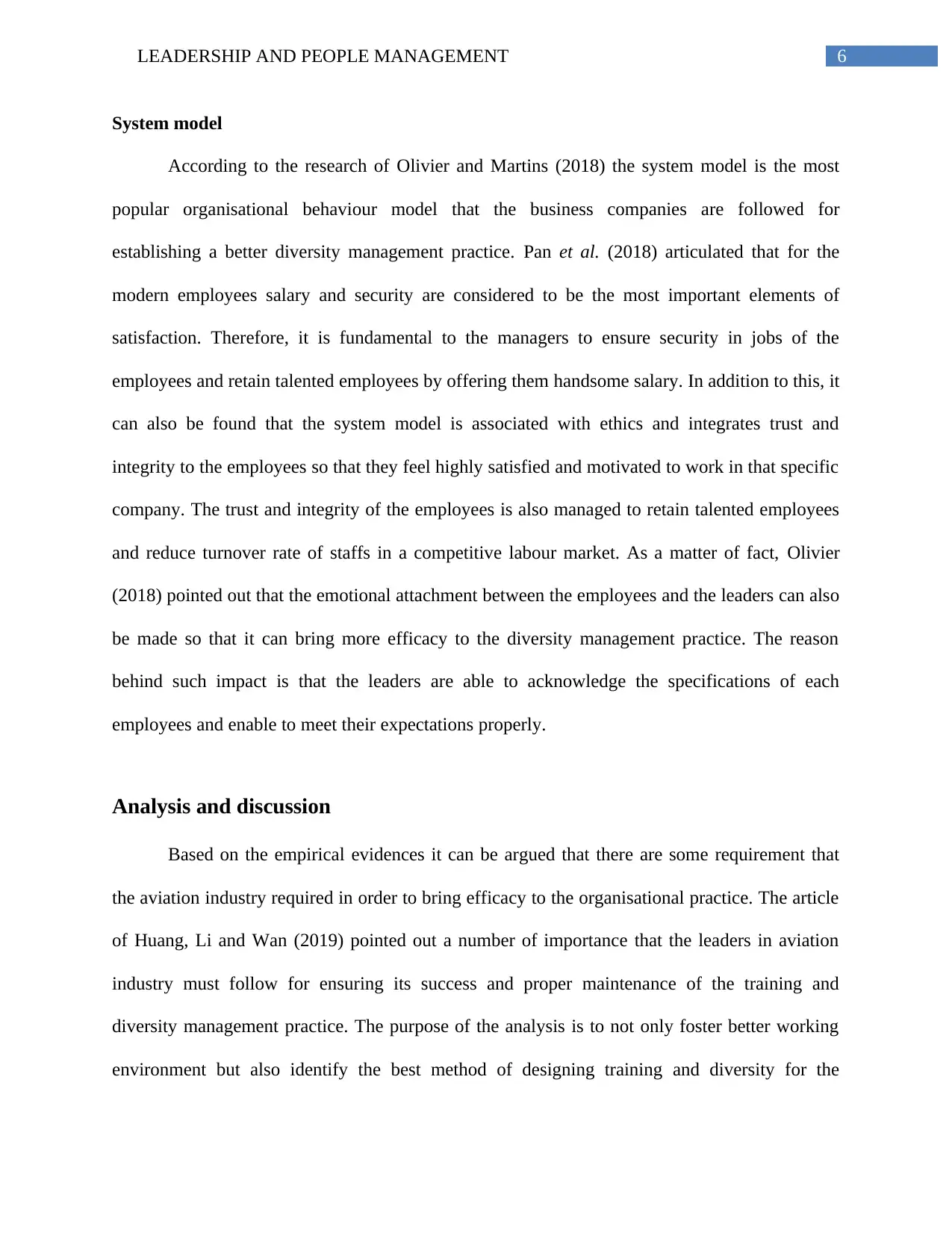
6LEADERSHIP AND PEOPLE MANAGEMENT
System model
According to the research of Olivier and Martins (2018) the system model is the most
popular organisational behaviour model that the business companies are followed for
establishing a better diversity management practice. Pan et al. (2018) articulated that for the
modern employees salary and security are considered to be the most important elements of
satisfaction. Therefore, it is fundamental to the managers to ensure security in jobs of the
employees and retain talented employees by offering them handsome salary. In addition to this, it
can also be found that the system model is associated with ethics and integrates trust and
integrity to the employees so that they feel highly satisfied and motivated to work in that specific
company. The trust and integrity of the employees is also managed to retain talented employees
and reduce turnover rate of staffs in a competitive labour market. As a matter of fact, Olivier
(2018) pointed out that the emotional attachment between the employees and the leaders can also
be made so that it can bring more efficacy to the diversity management practice. The reason
behind such impact is that the leaders are able to acknowledge the specifications of each
employees and enable to meet their expectations properly.
Analysis and discussion
Based on the empirical evidences it can be argued that there are some requirement that
the aviation industry required in order to bring efficacy to the organisational practice. The article
of Huang, Li and Wan (2019) pointed out a number of importance that the leaders in aviation
industry must follow for ensuring its success and proper maintenance of the training and
diversity management practice. The purpose of the analysis is to not only foster better working
environment but also identify the best method of designing training and diversity for the
System model
According to the research of Olivier and Martins (2018) the system model is the most
popular organisational behaviour model that the business companies are followed for
establishing a better diversity management practice. Pan et al. (2018) articulated that for the
modern employees salary and security are considered to be the most important elements of
satisfaction. Therefore, it is fundamental to the managers to ensure security in jobs of the
employees and retain talented employees by offering them handsome salary. In addition to this, it
can also be found that the system model is associated with ethics and integrates trust and
integrity to the employees so that they feel highly satisfied and motivated to work in that specific
company. The trust and integrity of the employees is also managed to retain talented employees
and reduce turnover rate of staffs in a competitive labour market. As a matter of fact, Olivier
(2018) pointed out that the emotional attachment between the employees and the leaders can also
be made so that it can bring more efficacy to the diversity management practice. The reason
behind such impact is that the leaders are able to acknowledge the specifications of each
employees and enable to meet their expectations properly.
Analysis and discussion
Based on the empirical evidences it can be argued that there are some requirement that
the aviation industry required in order to bring efficacy to the organisational practice. The article
of Huang, Li and Wan (2019) pointed out a number of importance that the leaders in aviation
industry must follow for ensuring its success and proper maintenance of the training and
diversity management practice. The purpose of the analysis is to not only foster better working
environment but also identify the best method of designing training and diversity for the
Paraphrase This Document
Need a fresh take? Get an instant paraphrase of this document with our AI Paraphraser
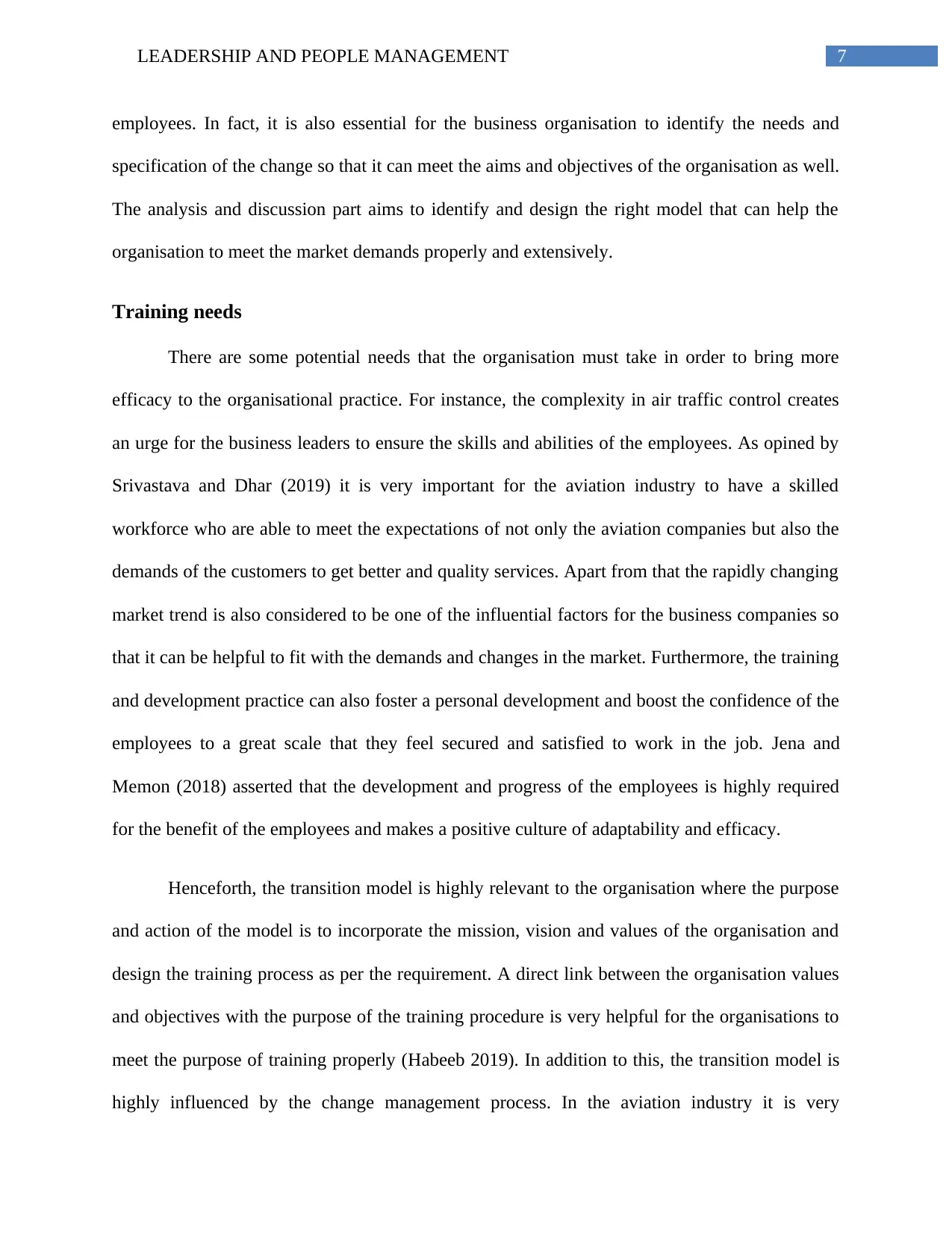
7LEADERSHIP AND PEOPLE MANAGEMENT
employees. In fact, it is also essential for the business organisation to identify the needs and
specification of the change so that it can meet the aims and objectives of the organisation as well.
The analysis and discussion part aims to identify and design the right model that can help the
organisation to meet the market demands properly and extensively.
Training needs
There are some potential needs that the organisation must take in order to bring more
efficacy to the organisational practice. For instance, the complexity in air traffic control creates
an urge for the business leaders to ensure the skills and abilities of the employees. As opined by
Srivastava and Dhar (2019) it is very important for the aviation industry to have a skilled
workforce who are able to meet the expectations of not only the aviation companies but also the
demands of the customers to get better and quality services. Apart from that the rapidly changing
market trend is also considered to be one of the influential factors for the business companies so
that it can be helpful to fit with the demands and changes in the market. Furthermore, the training
and development practice can also foster a personal development and boost the confidence of the
employees to a great scale that they feel secured and satisfied to work in the job. Jena and
Memon (2018) asserted that the development and progress of the employees is highly required
for the benefit of the employees and makes a positive culture of adaptability and efficacy.
Henceforth, the transition model is highly relevant to the organisation where the purpose
and action of the model is to incorporate the mission, vision and values of the organisation and
design the training process as per the requirement. A direct link between the organisation values
and objectives with the purpose of the training procedure is very helpful for the organisations to
meet the purpose of training properly (Habeeb 2019). In addition to this, the transition model is
highly influenced by the change management process. In the aviation industry it is very
employees. In fact, it is also essential for the business organisation to identify the needs and
specification of the change so that it can meet the aims and objectives of the organisation as well.
The analysis and discussion part aims to identify and design the right model that can help the
organisation to meet the market demands properly and extensively.
Training needs
There are some potential needs that the organisation must take in order to bring more
efficacy to the organisational practice. For instance, the complexity in air traffic control creates
an urge for the business leaders to ensure the skills and abilities of the employees. As opined by
Srivastava and Dhar (2019) it is very important for the aviation industry to have a skilled
workforce who are able to meet the expectations of not only the aviation companies but also the
demands of the customers to get better and quality services. Apart from that the rapidly changing
market trend is also considered to be one of the influential factors for the business companies so
that it can be helpful to fit with the demands and changes in the market. Furthermore, the training
and development practice can also foster a personal development and boost the confidence of the
employees to a great scale that they feel secured and satisfied to work in the job. Jena and
Memon (2018) asserted that the development and progress of the employees is highly required
for the benefit of the employees and makes a positive culture of adaptability and efficacy.
Henceforth, the transition model is highly relevant to the organisation where the purpose
and action of the model is to incorporate the mission, vision and values of the organisation and
design the training process as per the requirement. A direct link between the organisation values
and objectives with the purpose of the training procedure is very helpful for the organisations to
meet the purpose of training properly (Habeeb 2019). In addition to this, the transition model is
highly influenced by the change management process. In the aviation industry it is very
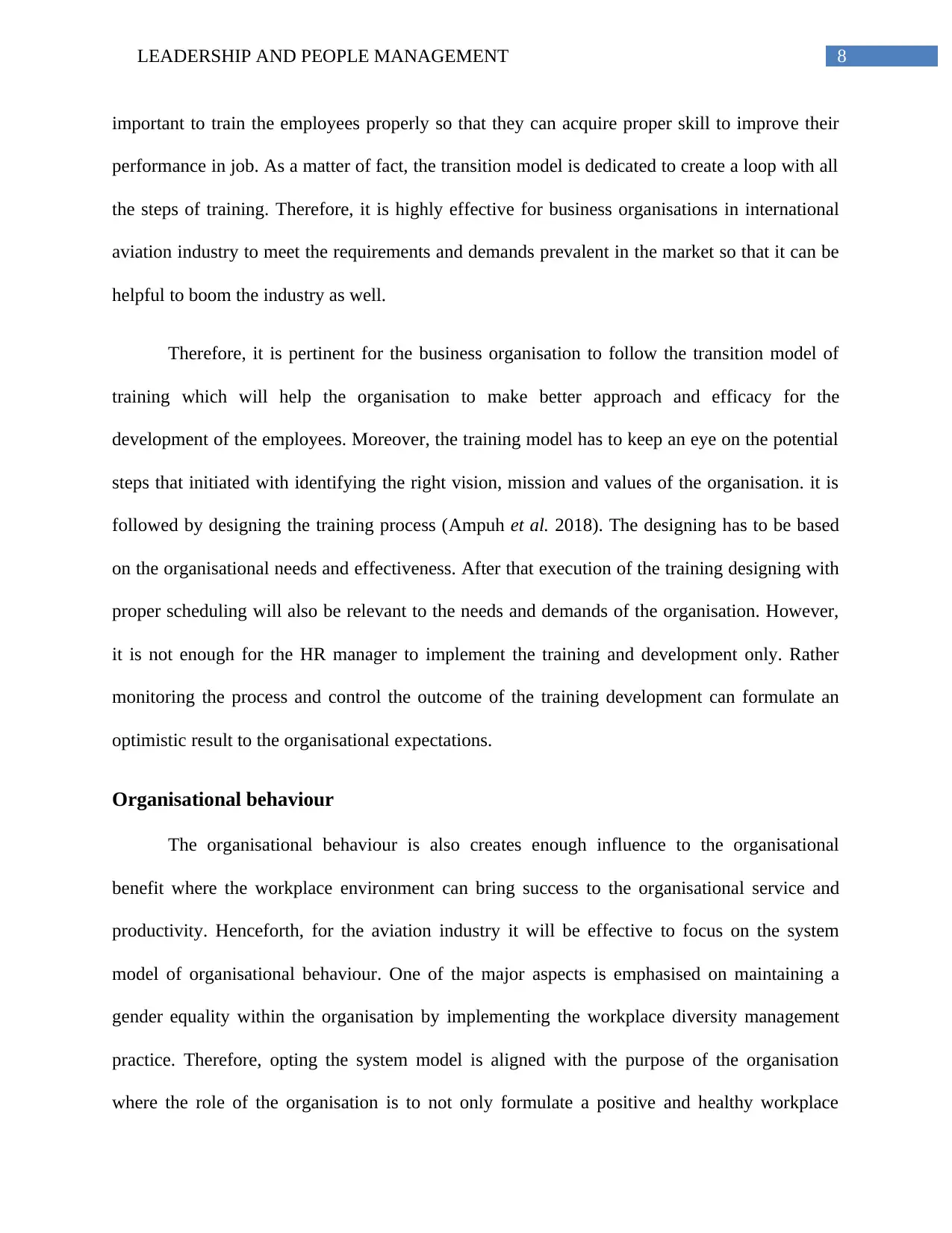
8LEADERSHIP AND PEOPLE MANAGEMENT
important to train the employees properly so that they can acquire proper skill to improve their
performance in job. As a matter of fact, the transition model is dedicated to create a loop with all
the steps of training. Therefore, it is highly effective for business organisations in international
aviation industry to meet the requirements and demands prevalent in the market so that it can be
helpful to boom the industry as well.
Therefore, it is pertinent for the business organisation to follow the transition model of
training which will help the organisation to make better approach and efficacy for the
development of the employees. Moreover, the training model has to keep an eye on the potential
steps that initiated with identifying the right vision, mission and values of the organisation. it is
followed by designing the training process (Ampuh et al. 2018). The designing has to be based
on the organisational needs and effectiveness. After that execution of the training designing with
proper scheduling will also be relevant to the needs and demands of the organisation. However,
it is not enough for the HR manager to implement the training and development only. Rather
monitoring the process and control the outcome of the training development can formulate an
optimistic result to the organisational expectations.
Organisational behaviour
The organisational behaviour is also creates enough influence to the organisational
benefit where the workplace environment can bring success to the organisational service and
productivity. Henceforth, for the aviation industry it will be effective to focus on the system
model of organisational behaviour. One of the major aspects is emphasised on maintaining a
gender equality within the organisation by implementing the workplace diversity management
practice. Therefore, opting the system model is aligned with the purpose of the organisation
where the role of the organisation is to not only formulate a positive and healthy workplace
important to train the employees properly so that they can acquire proper skill to improve their
performance in job. As a matter of fact, the transition model is dedicated to create a loop with all
the steps of training. Therefore, it is highly effective for business organisations in international
aviation industry to meet the requirements and demands prevalent in the market so that it can be
helpful to boom the industry as well.
Therefore, it is pertinent for the business organisation to follow the transition model of
training which will help the organisation to make better approach and efficacy for the
development of the employees. Moreover, the training model has to keep an eye on the potential
steps that initiated with identifying the right vision, mission and values of the organisation. it is
followed by designing the training process (Ampuh et al. 2018). The designing has to be based
on the organisational needs and effectiveness. After that execution of the training designing with
proper scheduling will also be relevant to the needs and demands of the organisation. However,
it is not enough for the HR manager to implement the training and development only. Rather
monitoring the process and control the outcome of the training development can formulate an
optimistic result to the organisational expectations.
Organisational behaviour
The organisational behaviour is also creates enough influence to the organisational
benefit where the workplace environment can bring success to the organisational service and
productivity. Henceforth, for the aviation industry it will be effective to focus on the system
model of organisational behaviour. One of the major aspects is emphasised on maintaining a
gender equality within the organisation by implementing the workplace diversity management
practice. Therefore, opting the system model is aligned with the purpose of the organisation
where the role of the organisation is to not only formulate a positive and healthy workplace
⊘ This is a preview!⊘
Do you want full access?
Subscribe today to unlock all pages.

Trusted by 1+ million students worldwide
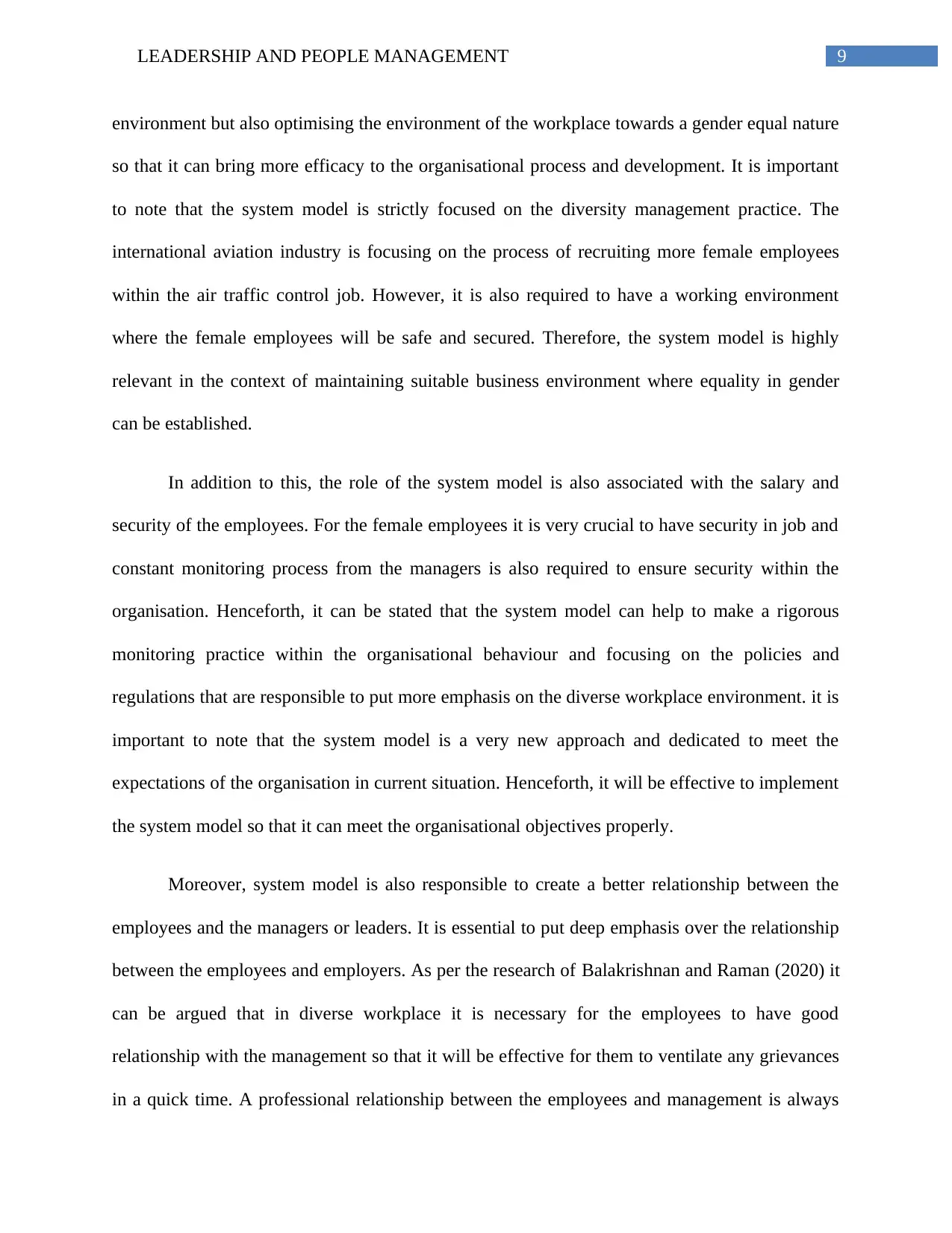
9LEADERSHIP AND PEOPLE MANAGEMENT
environment but also optimising the environment of the workplace towards a gender equal nature
so that it can bring more efficacy to the organisational process and development. It is important
to note that the system model is strictly focused on the diversity management practice. The
international aviation industry is focusing on the process of recruiting more female employees
within the air traffic control job. However, it is also required to have a working environment
where the female employees will be safe and secured. Therefore, the system model is highly
relevant in the context of maintaining suitable business environment where equality in gender
can be established.
In addition to this, the role of the system model is also associated with the salary and
security of the employees. For the female employees it is very crucial to have security in job and
constant monitoring process from the managers is also required to ensure security within the
organisation. Henceforth, it can be stated that the system model can help to make a rigorous
monitoring practice within the organisational behaviour and focusing on the policies and
regulations that are responsible to put more emphasis on the diverse workplace environment. it is
important to note that the system model is a very new approach and dedicated to meet the
expectations of the organisation in current situation. Henceforth, it will be effective to implement
the system model so that it can meet the organisational objectives properly.
Moreover, system model is also responsible to create a better relationship between the
employees and the managers or leaders. It is essential to put deep emphasis over the relationship
between the employees and employers. As per the research of Balakrishnan and Raman (2020) it
can be argued that in diverse workplace it is necessary for the employees to have good
relationship with the management so that it will be effective for them to ventilate any grievances
in a quick time. A professional relationship between the employees and management is always
environment but also optimising the environment of the workplace towards a gender equal nature
so that it can bring more efficacy to the organisational process and development. It is important
to note that the system model is strictly focused on the diversity management practice. The
international aviation industry is focusing on the process of recruiting more female employees
within the air traffic control job. However, it is also required to have a working environment
where the female employees will be safe and secured. Therefore, the system model is highly
relevant in the context of maintaining suitable business environment where equality in gender
can be established.
In addition to this, the role of the system model is also associated with the salary and
security of the employees. For the female employees it is very crucial to have security in job and
constant monitoring process from the managers is also required to ensure security within the
organisation. Henceforth, it can be stated that the system model can help to make a rigorous
monitoring practice within the organisational behaviour and focusing on the policies and
regulations that are responsible to put more emphasis on the diverse workplace environment. it is
important to note that the system model is a very new approach and dedicated to meet the
expectations of the organisation in current situation. Henceforth, it will be effective to implement
the system model so that it can meet the organisational objectives properly.
Moreover, system model is also responsible to create a better relationship between the
employees and the managers or leaders. It is essential to put deep emphasis over the relationship
between the employees and employers. As per the research of Balakrishnan and Raman (2020) it
can be argued that in diverse workplace it is necessary for the employees to have good
relationship with the management so that it will be effective for them to ventilate any grievances
in a quick time. A professional relationship between the employees and management is always
Paraphrase This Document
Need a fresh take? Get an instant paraphrase of this document with our AI Paraphraser
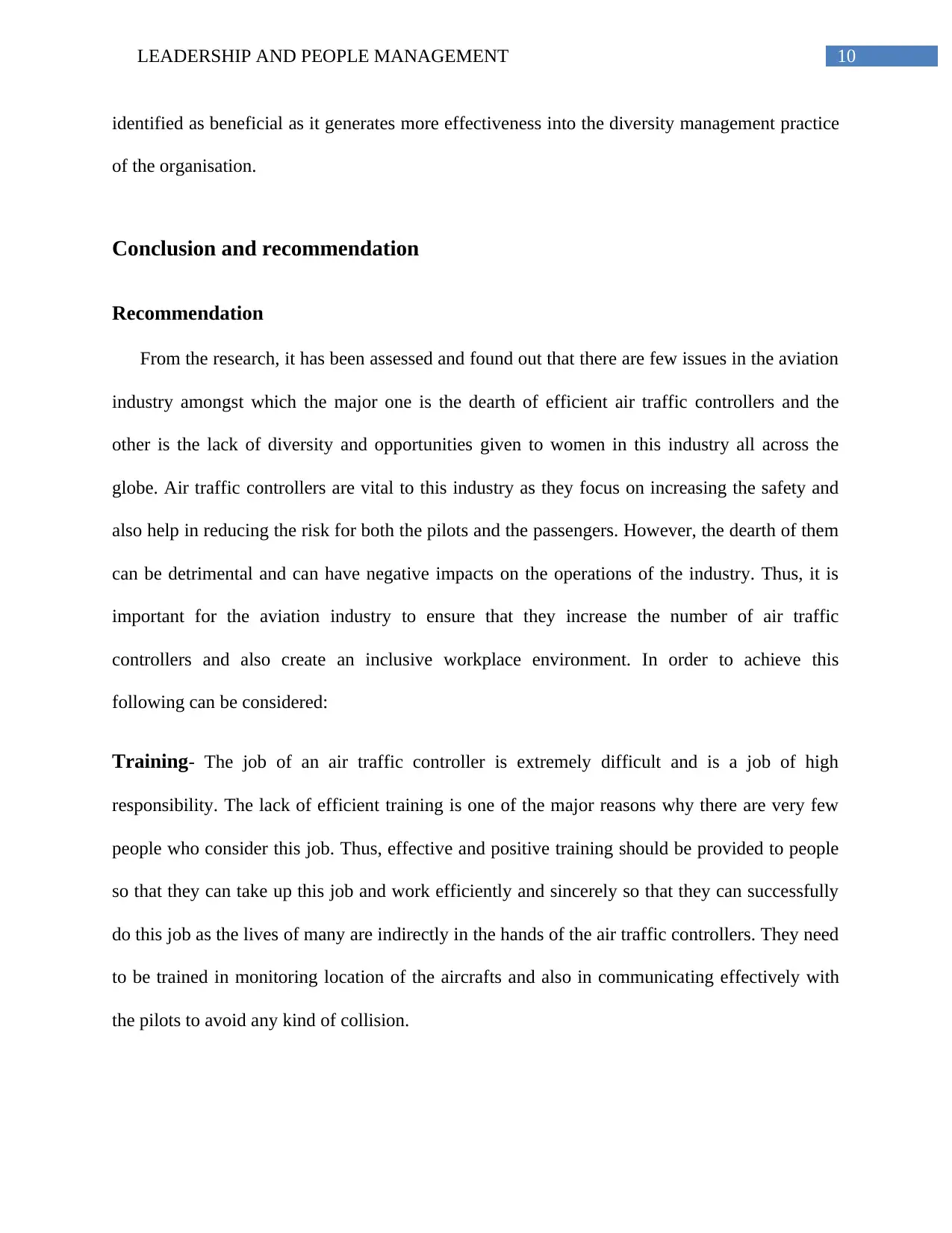
10LEADERSHIP AND PEOPLE MANAGEMENT
identified as beneficial as it generates more effectiveness into the diversity management practice
of the organisation.
Conclusion and recommendation
Recommendation
From the research, it has been assessed and found out that there are few issues in the aviation
industry amongst which the major one is the dearth of efficient air traffic controllers and the
other is the lack of diversity and opportunities given to women in this industry all across the
globe. Air traffic controllers are vital to this industry as they focus on increasing the safety and
also help in reducing the risk for both the pilots and the passengers. However, the dearth of them
can be detrimental and can have negative impacts on the operations of the industry. Thus, it is
important for the aviation industry to ensure that they increase the number of air traffic
controllers and also create an inclusive workplace environment. In order to achieve this
following can be considered:
Training- The job of an air traffic controller is extremely difficult and is a job of high
responsibility. The lack of efficient training is one of the major reasons why there are very few
people who consider this job. Thus, effective and positive training should be provided to people
so that they can take up this job and work efficiently and sincerely so that they can successfully
do this job as the lives of many are indirectly in the hands of the air traffic controllers. They need
to be trained in monitoring location of the aircrafts and also in communicating effectively with
the pilots to avoid any kind of collision.
identified as beneficial as it generates more effectiveness into the diversity management practice
of the organisation.
Conclusion and recommendation
Recommendation
From the research, it has been assessed and found out that there are few issues in the aviation
industry amongst which the major one is the dearth of efficient air traffic controllers and the
other is the lack of diversity and opportunities given to women in this industry all across the
globe. Air traffic controllers are vital to this industry as they focus on increasing the safety and
also help in reducing the risk for both the pilots and the passengers. However, the dearth of them
can be detrimental and can have negative impacts on the operations of the industry. Thus, it is
important for the aviation industry to ensure that they increase the number of air traffic
controllers and also create an inclusive workplace environment. In order to achieve this
following can be considered:
Training- The job of an air traffic controller is extremely difficult and is a job of high
responsibility. The lack of efficient training is one of the major reasons why there are very few
people who consider this job. Thus, effective and positive training should be provided to people
so that they can take up this job and work efficiently and sincerely so that they can successfully
do this job as the lives of many are indirectly in the hands of the air traffic controllers. They need
to be trained in monitoring location of the aircrafts and also in communicating effectively with
the pilots to avoid any kind of collision.
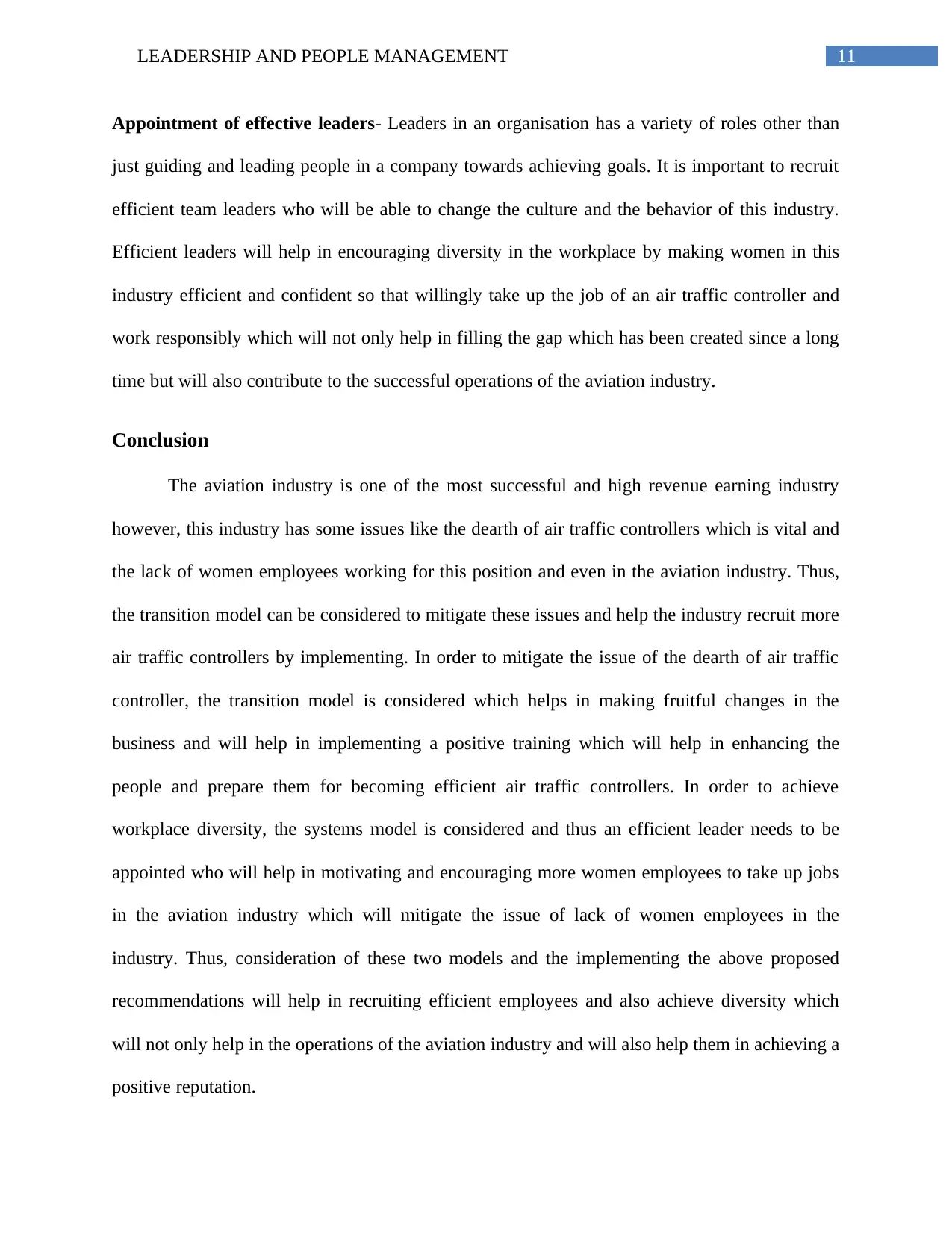
11LEADERSHIP AND PEOPLE MANAGEMENT
Appointment of effective leaders- Leaders in an organisation has a variety of roles other than
just guiding and leading people in a company towards achieving goals. It is important to recruit
efficient team leaders who will be able to change the culture and the behavior of this industry.
Efficient leaders will help in encouraging diversity in the workplace by making women in this
industry efficient and confident so that willingly take up the job of an air traffic controller and
work responsibly which will not only help in filling the gap which has been created since a long
time but will also contribute to the successful operations of the aviation industry.
Conclusion
The aviation industry is one of the most successful and high revenue earning industry
however, this industry has some issues like the dearth of air traffic controllers which is vital and
the lack of women employees working for this position and even in the aviation industry. Thus,
the transition model can be considered to mitigate these issues and help the industry recruit more
air traffic controllers by implementing. In order to mitigate the issue of the dearth of air traffic
controller, the transition model is considered which helps in making fruitful changes in the
business and will help in implementing a positive training which will help in enhancing the
people and prepare them for becoming efficient air traffic controllers. In order to achieve
workplace diversity, the systems model is considered and thus an efficient leader needs to be
appointed who will help in motivating and encouraging more women employees to take up jobs
in the aviation industry which will mitigate the issue of lack of women employees in the
industry. Thus, consideration of these two models and the implementing the above proposed
recommendations will help in recruiting efficient employees and also achieve diversity which
will not only help in the operations of the aviation industry and will also help them in achieving a
positive reputation.
Appointment of effective leaders- Leaders in an organisation has a variety of roles other than
just guiding and leading people in a company towards achieving goals. It is important to recruit
efficient team leaders who will be able to change the culture and the behavior of this industry.
Efficient leaders will help in encouraging diversity in the workplace by making women in this
industry efficient and confident so that willingly take up the job of an air traffic controller and
work responsibly which will not only help in filling the gap which has been created since a long
time but will also contribute to the successful operations of the aviation industry.
Conclusion
The aviation industry is one of the most successful and high revenue earning industry
however, this industry has some issues like the dearth of air traffic controllers which is vital and
the lack of women employees working for this position and even in the aviation industry. Thus,
the transition model can be considered to mitigate these issues and help the industry recruit more
air traffic controllers by implementing. In order to mitigate the issue of the dearth of air traffic
controller, the transition model is considered which helps in making fruitful changes in the
business and will help in implementing a positive training which will help in enhancing the
people and prepare them for becoming efficient air traffic controllers. In order to achieve
workplace diversity, the systems model is considered and thus an efficient leader needs to be
appointed who will help in motivating and encouraging more women employees to take up jobs
in the aviation industry which will mitigate the issue of lack of women employees in the
industry. Thus, consideration of these two models and the implementing the above proposed
recommendations will help in recruiting efficient employees and also achieve diversity which
will not only help in the operations of the aviation industry and will also help them in achieving a
positive reputation.
⊘ This is a preview!⊘
Do you want full access?
Subscribe today to unlock all pages.

Trusted by 1+ million students worldwide
1 out of 15
Related Documents
Your All-in-One AI-Powered Toolkit for Academic Success.
+13062052269
info@desklib.com
Available 24*7 on WhatsApp / Email
![[object Object]](/_next/static/media/star-bottom.7253800d.svg)
Unlock your academic potential
Copyright © 2020–2025 A2Z Services. All Rights Reserved. Developed and managed by ZUCOL.





